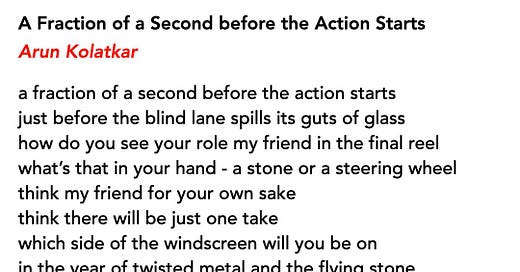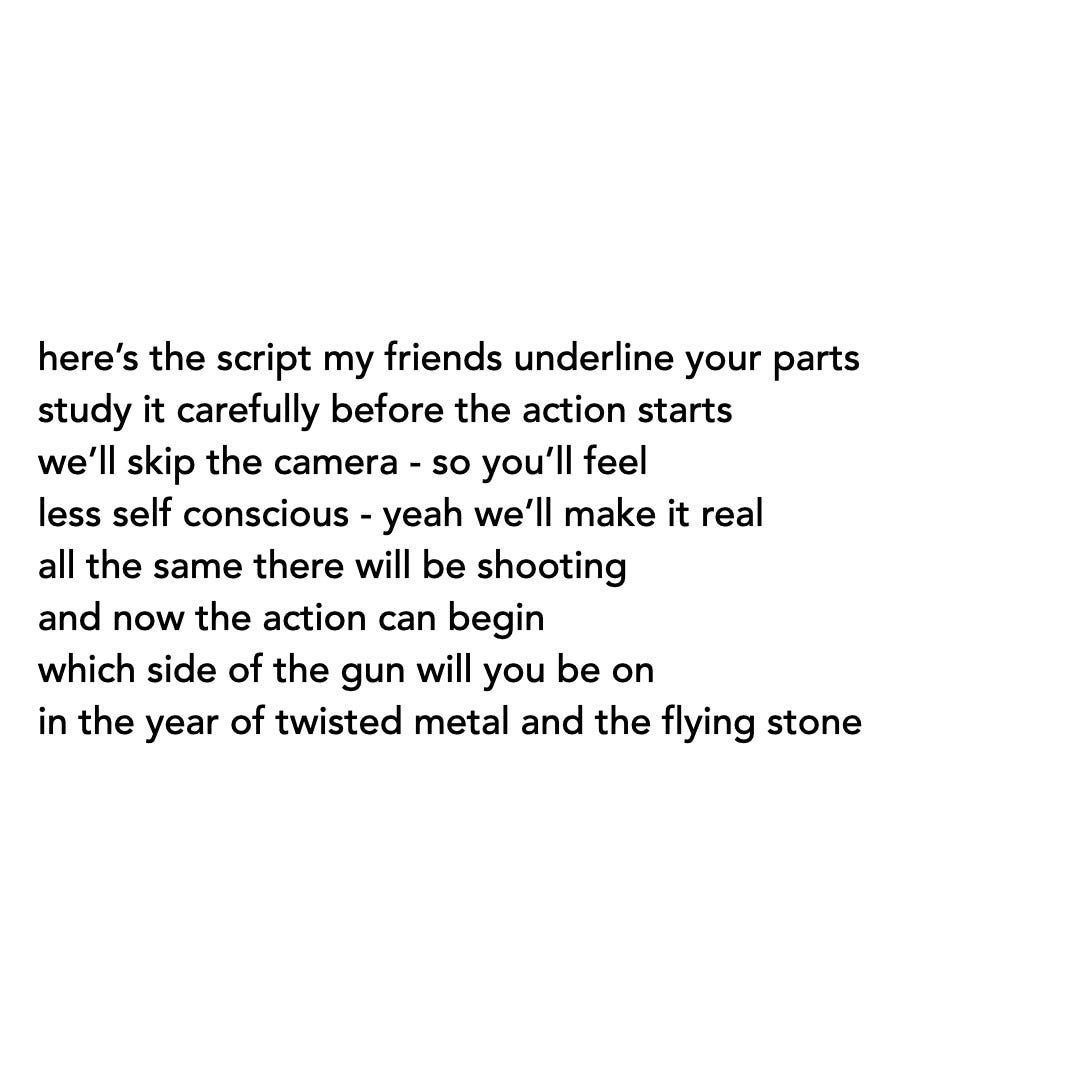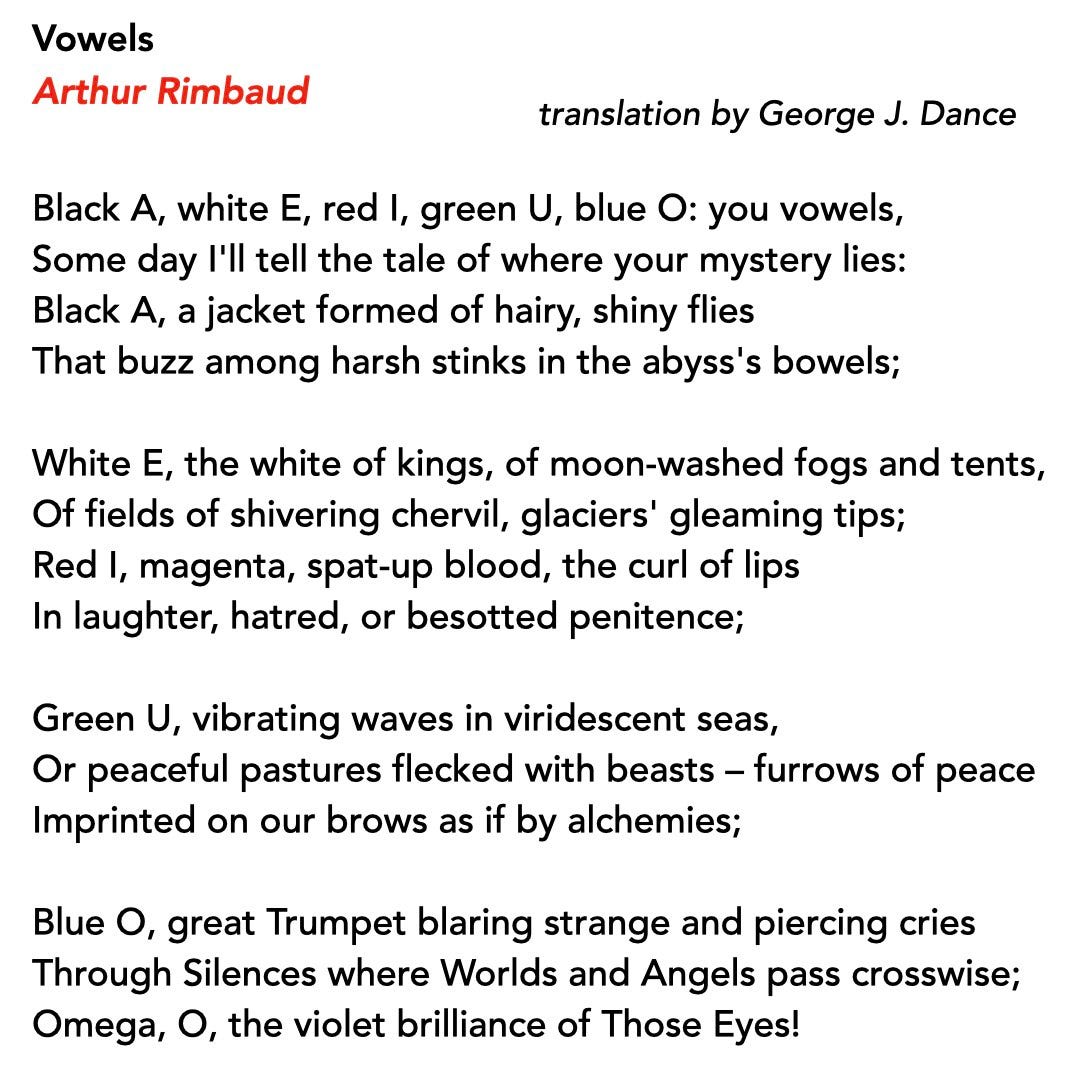misshapen chaos of well-seeming forms
synesthesia and poetry with Kolatkar, Rimbaud, and Shakespeare
good day, dear reader.
before the commentary goes any further,
you will notice that i have asked my poet friend kolatkar to distract you with his endless prattling. it is a gorgeous little piece of writing is it not? i love how ordinary kolatkar is. how beautifully he captures the moment, the event, and its becoming, in all its granularity - in its floundering sheen. the gust and guile of his phrasing grows on the reader the way moss paints damp walls over many years of rain.
i thrust this poem on you first thing today, with a very particular reasoning. the persona seems to be speaking to a bit-actor or an extra at a set in the city of bombay.
is this a realistic poem? is it speculation? or fantasy punctuated by his uncanny attention to detail that makes it real? is it imagination - is this the imagined city?
the city. yes. this commentary begins with a reminder about the ‘Meanwhile City Writing Anthology’. i thought it best to share a poem by the poet whose writings about bombay have been instrumental in shaping my vision for the project. the idea emerged from my engagement with the ‘urban’ as a frame of enquiry within artistic practice - and kolatkar’s vision of the city that i call home has guided my enquiry right from the moment i first read Kala Ghoda Poems. the ‘urban’, not the ‘city’, leaps at the reader from unexpected places in kolatkar’s writing.
it was refreshing and reassuring to see glimpses of this same sensibility in the poems that were submitted to the original call for Bombay/Mumbai City poems. i use this opportunity to remind the writers reading this commentary that the deadline of the call for “City Writing” for the 'Meanwhile' Anthology is on August 7th. last 3 days, folks, make sure you don’t miss it!
new readers (and old) please do spread the word. it’d be disappointing to miss out on fresh voices simply because of the limited reach of this newsletter.
now, getting back to kolatkar’s writing.
my close reading of his poems has made me think deeply about the role the senses play in the arts. critics have commented extensively on the ‘visual’ in kolatkar’s poetry. Ashok Shahane, kolatkar’s publisher, emphasised this element in a conversation with me: “he is an artist only. he hides paintings behind his words”. elsewhere, arun khopkar speaks about the “cinematic” in kolatkar’s poetry.
cinema for kolatkar was trope, metaphor and perceptive frame. the self-reflexive speculative style, evident even in today’s poem, is distinct from his use of ‘bambaiyya hindi/marathi’. this cinematic framing allows him to go deep into the real with a gaze that does not devolve into the freedom of romanticism, or the sensorial excess of realism. this is something else, and the more i read of his writing, the more i feel that the key to this question of how the artist ‘witnesses’ the city, lies in the senses. let me try and explain, by means of illustration, what i mean.
does it happen with you, dear reader, that a melody or a piece of music sits in the ear of the mind, and spreads its wings in the heart. sometimes i end up humming a single raag for days. i return to it on and off at different times in different places. sometimes the way a smile grows in the face of a friend reminds me of the slow ascent of a musical note. yesterday, for example, a heated ideological debate with a dear friend ended up in laughter and reconciliation. the transition from fury to laughter, that begin at the edge of his lips, and climbed reluctantly into his eyes before settling there, lodged in my mind as if it was a stone thrown by an angry boy, that refused to bounce off a mud wall, embedding itself, instead, in the soft wet earthy womb instead.
this morning as i listened to Bade Ustad’s bilaskhani todi, the memory of that transition of feeling came hurtling back at me. at the start of the second minute of the recording, the string moves from the gandhaar to the pancham in the lower octave. this is the first time the pancham is revealed. and the raag smiles in that moment - a plateau is reached. vision accompanies sound.
perception is a complex thing. and the more i read about the ways in which our mind perceives and processes experience, the more i am convinced of the ephemerality of truth as an ideal to which the artist aspires. this frees the poet’s hand. i am not imprisoned by the impulse to convey the reality or authenticity of what i sense, or what a character senses. rather, i pay attention to the layers and colours of feeling evoked by objects of perception and synesthetic excess.
it is a journey, this seeing, hearing, smelling, tasting and touching. these sensations occur simultaneously and sometimes even unconsciously. maybe one sense is busy in an activity. maybe a person is reading a book or searching for an address. eyes are busy scanning shopfronts or processing the shapes of words, while simultaneously making meaning. suddenly, without realising the person wrinkles their nose, and sniffs. they feel disgust. for a single moment, they register the emotion, but not the recognition of the smell. there’s a minuscule hiatus before they realise that somebody farted in the room or the auto passed a garbage dump. is there not? (Massumi has spoken about this hiatus at length, through his observations on a medical experiment or two)
if we double back and think about the line from perception to experience, and then, finally, expression, i wager that much of the work of the artist lies in the articulation of sensorial experience. this articulation takes the form of description of sensation, feeling or empirical fact, which is then double voiced as epiphany/wisdom/beauty.
but the senses exist in a space that has no beginning or end, no real singularity or consistency. if you read ‘Pi-Dog’, the first poem in Kala Ghoda Poems, for instance, the non human persona travels through a range of sensorial descriptions that shape various layers of the urban experience. sitting alongside Ugh the dog, the city assaults the reader first through the eye, and then through the ear and the nose, the tongue, and finally, through touch. it is a synesthetic construction that defies linearity. the sensations emerge in a profusion of interweaving threads defying any essentialising perspective that hones in on each of them through their singularity. while each articulation of sense can be drawn out as a discursive presence, taken together they form a chaotic harmony; a kind of fragmented body whose organs are points and streaks that pull each other in different directions, while the thing that stubbornly holds them together in an “urban spirit”, or a tongue-in-cheek mood. the colours of this body are the meanings and lifeworlds attached to each sound, smell, taste, sight, or touch - taken individually and together.
synesthesia as literary device and metaphor (not neurological condition or ‘faculty’) has fascinated me for a long time. the form must reflect the experience, and our ways of parsing reality are not straightforward. has it not happened that language is sometimes fails our creative faculties while trying to describe the smell of a place, or the texture of a sound. synesthetic phrasing or the use of metaphor to intersperse the senses abounds in kolatkar’s writing (for instance: ‘the sun like a hammer on the head’), and indeed in our daily language (they have such a sweet smile).
perhaps the most popular explication of synesthetic experience is Rimbaud’s Voyelles.
while this sonnet represents one of the most celebrated instances of synesthetic expression, it is not the first, and its sophistry somewhat diminishes its sensory particularity, in my humble opinion. however, placed within the context of the poem’s creation, this is by no means a humble achievement. sociologists, philosophors and literary critics have written tomes that claim to interpret the meaning of the sonnet.
i am interested in the way in which sense constructs space and embodiment - not only through emplacement or association, but simultaneity. it is important to note that etymologically, the term synesthesia can be traced to greek origins - syn- "together" (see syn-) + aisthēsis "feeling" (from PIE root *au- "to perceive"). so “perceive together”. this locates the term’s true origins in neurological phenomena. Richard E. Cytowic, a medical doctor, researcher, and one of the most popular modern theorists of synesthesia, makes a provocation about it being a sharpened faculty, such as ‘perfect pitch’ is in some musicians or aesthetes, as opposed to it be a neurological defect. while the ‘condition’ of synesthesia has been abundantly studied by scientists and psychologists (and i am yet to immerse myself completely in this literature), i am more interested in the poet’s use of sensory data to unhinge habitual notions of the everyday. these observations can say something about a culture, about identity and sociality, even about social movements and phenomena. it is a widening, not only of imagination, but, eventually, also of perception.
my first tryst with senses being associated with emotions, feelings, or being joined with other senses comes from Shakespeare (‘green-eyed envy’, for instance). there is a passage in Romeo and Juliet, which has stayed with me through all these years, and slips into my tongue in moments of lovelorn wandering, or existential dread. this passage evokes with astounding intensity, the poetic sensibility that births synesthesia:
“O heavy lightness, serious vanity,
Misshapen chaos of well-seeming forms,
Feather of lead, bright smoke, cold fire, sick health,
Still-waking sleep that is not what it is!
This love feel I, that feel no love in this.”
reader, you might object- this is more oxymoron than synesthesia, merely a symptom of the exhaustion and frustration of the fleeting fancies of a lovestruck youth. and you are right, to an extent. but my provocation rests on the splintering of perception, not language. ‘cold fire’ shocks the prevalent association of the material, through sensory dissonance. if the fire became red, or green (in Macbeth, there is the exhortation ‘these would rather the multitudinous seas incarnadine’) or the colour of afternoon; if its sound lived in darkness and grew horns that prick the belly of the sky, then would that be synesthetic? well, at least it would deepen romeo’s romantic languishing for the reader/audience.
the structuralist Claude Levi-Strauss argues that rimbaud’s Voyelles is an exercise in opposition rather than aggregation or exploration - that rimbaud defeats existing associations between the alphabets and emotions, visions, thoughtscapes. this could happen rather intuitively. the phrase “to know” someone (“I have known you”) meant something quite different in Elizabethan England from what it means today.
times change, places change, ways of sensing change. the poet is the archivist who documents these changes through their art.
ah, well.. that’s my cue….
time to bid adieu…
the morning is aquamarine. the breeze, whose breath is pungent, brings news of the week to come. birdsong climbs the curling vine of dawn, and the first calls of milkmen and pao-wallahs floats through the gathering bright. bilaskhani continues in the background, transparent with languor and the gnarled persistence of brown withered bark.
i sit at my chair beside a window that opens to the misshapen chaos of well-seeming forms.
the city is awake now.
again.
good morning…
thankyou for listening.
do write to poetly@pm.me if you have any questions, queries, or comments.
i will write back as soon as I find the space, and the time.
If you like what you read, do consider ‘buying me a coffee’.





